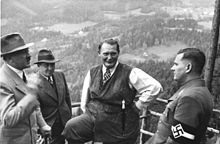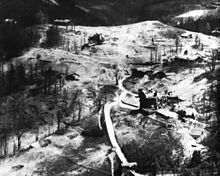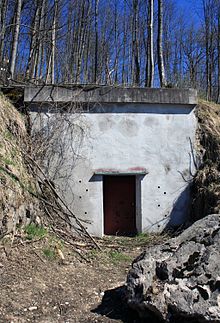- Obersalzberg
-
Obersalzberg is a mountainside retreat situated above the market town of Berchtesgaden in Bavaria, Germany, located about 120 kilometres (75 mi) southeast of Munich, close to the border with Austria. The area is best known as the location of Adolf Hitler's mountain residence, the Berghof, and for the nearby Kehlsteinhaus, more popularly known as the Eagle's Nest.
Contents
History
The name of the settlement area derives from the rock salt mining in the former Berchtesgaden Provostry documented since the 12th century. It was part of the Salzberg municipality, which was incorporated into Berchtesgaden in 1972.
Hitler's retreat
In the late 19th century German industrialists like Carl von Linde had begun using the area as a vacation retreat in both winter and summer. The scenic landscape with its sweeping mountain views also attracted Hitler, who came to know Berchtesgaden through his party fellow Dietrich Eckart in the course of the Beer Hall Putsch in 1923, just before his imprisonment at Landsberg. He became so fond of the area that by 1928 he began renting a small chalet called Haus Wachenfeld from the widow of a Buxtehude manufacturer. The Obersalzberg was also where Hitler dictated Part Two of Mein Kampf, which earned him large royalties.
Several months after Hitler's appointment as Chancellor of Germany he purchased the home in the summer of 1933 and began making three important renovations. The first included window shutters and a small office, followed a year later by a winter garden and stone and finally the third and most extensive came in 1935-1936 when the former Haus Wachenfeld was finally transformed into the sprawling landhaus known as the Berghof. Obersalzberg became an overcrowded venue for Hitler's admirers from all over the land and beyond, which began to cause problems with the local population.
Security zones
Around Hitler's home, several Nazi leaders such as Hermann Göring, Martin Bormann and Albert Speer acquired residences. By 1935-36 Party Secretary Bormann had all residents of Obersalzberg either bought out or evicted, and three security zones were installed that encompassed the entire area.[1] The expropriation not only concerned the secondary residences, but also several Alpine farms local families had held for centuries. After the demolition of the existing development, the so-called Führersperrgebiet shielded Hitler and his staff from public access. Two other security zones protected the heavily expanded SS and SD barracks, support staff, guest houses, underground bunkers and air raid shelters.
From 1938 Bormann also had the Kehlsteinhaus lodge erected on a rocky promontory, including a lift system from the upper end of the access road. It was presented to Hitler on his 50th birthday in 1939, he nevertheless seldom visited it, though he and his mistress Eva Braun spent much time at Obersalzberg. From 1937 the German Reich Chancellery maintained a second seat in the nearby village of Bischofswiesen with Hitler receiving numerous guests of state at the Berghof. His last known visit was in 1944, he left for his Wolf's Lair headquarter on July 14 (see: 1944 Adolf Hitler assassination attempt) and never returned.
The premises - except for the Kehlsteinhaus - were heavily damaged by an Allied air raid on 25 April 1945. The remains were set on fire by retiring SS troops and plundered by locals.
US Army
US troops occupied the area on May 4. The former Nazi Party realties officially passed to the State of Bavaria in 1947, who instead of restoring them to their original owners sold it to the Steigenberger Hotels company. However, the Obersalzberg remained in use as a recreation park by the US military. Several houses like the later General Walker Hotel were rebuilt, while the ruins of Hitler's, Göring's and Bormann's residences had been slighted. The contract with Steigenberger was reversed in 1964.
The Americans did not withdraw until 1996, whereafter the Bavarian state government resolved upon the erection of a hotel (since 2005 operated by the InterContinental Hotels Group) as well as the Dokumentationszentrum Obersalzberg on the area's history, run by the Munich Institut für Zeitgeschichte.
Buildings during the Reich
- Berghof (Hitler's private home)
- Partei-Gästehauses „Hoher Göll“/Today Dokumentationszentrum Obersalzberg
- Gutshof
- SS Kaserne, Barracks
- Gärtnerei/nursery
- Kehlsteinhaus ("Eagle's Nest")[2]
- Pension Moritz
- Platterhof/later General Walker Hotel
- Mooslahnerkopf Teehaus
- Hotel zum Türken/RSD, Sicherheitsdienst, Security Service
- Kamphäusl/Hitler dictates part two of Mein kampf
- Gutshof/Today SkyTop Lodge, Golf course restaurant/pro shop
- The houses of Martin Bormann, Hermann Göring and Albert Speer
See also
- Dokumentationszentrum Obersalzberg
- National Redoubt (the supposed Nazi "Alpenfestung" [Alpine Fortress])
- Bavaria
- Salzburgerland
References
- ^ http://www.thirdreichruins.com/obersalzberg.htm
- ^ http://www.thirdreichruins.com/kehlsteinhaus.htm
External links
Categories:- Geography of Germany
- Berchtesgadener Land
- Berchtesgaden Alps
Wikimedia Foundation. 2010.





